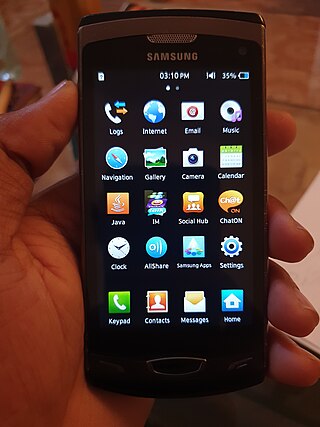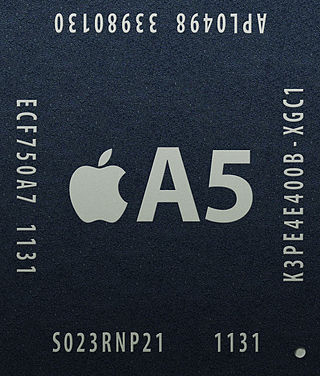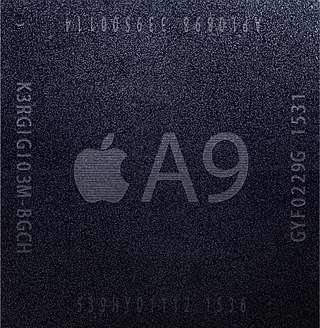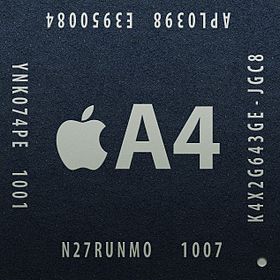
The OMAP family, developed by Texas Instruments, was a series of image/video processors. They are proprietary system on chips (SoCs) for portable and mobile multimedia applications. OMAP devices generally include a general-purpose ARM architecture processor core plus one or more specialized co-processors. Earlier OMAP variants commonly featured a variant of the Texas Instruments TMS320 series digital signal processor.

Arm is a British semiconductor and software design company based in Cambridge, England whose primary business is the design of ARM processors (CPUs). It also designs other chips, provides software development tools under the DS-5, RealView and Keil brands, and provides systems and platforms, system-on-a-chip (SoC) infrastructure and software. As a "holding" company, it also holds shares of other companies. Since 2016, it has been owned by Japanese conglomerate SoftBank Group.

The Nexus S 4G is a smartphone co-developed by Google and Samsung and manufactured by Samsung Electronics for release in 2010. It was the first smartphone to use the Android 2.3 "Gingerbread" operating system, and the first Android device to support Near Field Communication (NFC) in both hardware and software.

The Samsung Wave II S8530 is the successor of the Samsung Wave S8500 smartphone running the Bada 1.2 operating system designed by Samsung, which was commercially released in October 2010. The Wave is a slim touchscreen phone powered by Samsung's "Hummingbird" CPU, which includes a 1 GHz ARM Cortex-8 CPU and a built-in PowerVR SGX 540 graphics engine, "Super LCD" display and 720p high-definition video capture capabilities.SlashGear speculated that the phone could be the result of a rumored AMOLED panel shortage.

The Apple A5 is a 32-bit system on a chip (SoC) designed by Apple Inc. and manufactured by Samsung. The first product Apple featured an A5 in was the iPad 2. Apple claimed during their media event on March 2, 2011, that the ARM Cortex-A9 central processing unit (CPU) in the A5 is up to two times faster than the CPU in the Apple A4, and the PowerVR SGX543MP2 graphics processing unit (GPU) in the A5 is up to nine times faster than the GPU in the A4. Apple also claimed that the A5 uses the same amount of power as the A4.

Apple silicon is a series of system on a chip (SoC) and system in a package (SiP) processors designed by Apple Inc., mainly using the ARM architecture. They are the basis of Mac, iPhone, iPad, Apple TV, Apple Watch, AirPods, AirTag, HomePod, and Apple Vision Pro devices.

The Apple A5X is a 32-bit system on a chip (SoC) designed by Apple Inc. and manufactured by Samsung. Apple used it only in the third-generation iPad. The A5X is a high-performance variant of the Apple A5. Apple claimed during their media event on March 7, 2012 that the quad-core PowerVR SGX543MP4 graphics processing unit (GPU) in the A5X is two times faster than the GPU in the A5, as the A5X GPU contains two more cores than the dual-core version GPU in the A5.

The Apple A6 is a 32-bit package on package (PoP) system on a chip (SoC) designed by Apple Inc. that was introduced on September 12, 2012 at the launch of the iPhone 5. Apple states that it is up to twice as fast and has up to twice the graphics power compared with its predecessor, the Apple A5. Software updates for the chip ended in 2019, with the release of iOS 10.3.4 on the iPhone 5, since it was unsupported with the release of iOS 11 in 2017.
The Apple A7 is a 64-bit system on a chip (SoC) designed by Apple Inc. It first appeared in the iPhone 5S, which was announced on September 10, 2013, and the iPad Air and iPad Mini 2, which were both announced on October 22, 2013. Apple states that it is up to twice as fast and has up to twice the graphics power compared to its predecessor, the Apple A6. It is the first 64-bit SoC to ship in a consumer smartphone or tablet computer. On March 21, 2017, the iPad mini 2 was discontinued, ending production of A7 chips. The latest software update for systems using this chip was iOS 12.5.7, released on January 23, 2023, as they were discontinued with the release of iOS 13 and iPadOS 13 in 2019.

The Apple A6X is a 32-bit system-on-a-chip (SoC) designed by Apple Inc., introduced at the launch of the 4th generation iPad on October 23, 2012. It is a high-performance variant of the Apple A6 and the last 32-bit chip Apple used on an iOS device before Apple switched to 64-bit. Apple claims the A6X has twice the CPU performance and up to twice the graphics performance of its predecessor, the Apple A5X. Software updates for the 4th generation iPad ended in 2019 with the release of iOS 10.3.4 for cellular models, thus ceasing support for this chip as it was discontinued with the release of iOS 11 in 2017.

The Apple M-series coprocessors are motion coprocessors used by Apple Inc. in their mobile devices. First released in 2013, their function is to collect sensor data from integrated accelerometers, gyroscopes and compasses and offload the collecting and processing of sensor data from the main central processing unit (CPU).
The Apple A8 is a 64-bit ARM-based system on a chip (SoC) designed by Apple Inc. It first appeared in the iPhone 6 and iPhone 6 Plus, which were introduced on September 9, 2014. Apple states that it has 25% more CPU performance and 50% more graphics performance while drawing only 50% of the power of its predecessor, the Apple A7. The latest software updates for the 1.1GHz and 1.4GHz variants systems using this chip are iOS 12.5.7, released on January 23, 2023 as they were discontinued with the release of iOS 13 in 2019, and 1.5GHz variant for the iPad Mini 4 is iPadOS 15.7.7, released on June 21, 2023 as it was discontinued with the release of iPadOS 16 in 2022, while updates for the 1.5GHz variant continue for Apple TV HD. The A8 chip was discontinued on October 18, 2022, following the discontinuation of the Apple TV HD.

The Apple A8X is a 64-bit ARM-based system on a chip (SoC) designed by Apple Inc. and manufactured by TSMC. It first appeared in the iPad Air 2 and only is used in the iPad Air 2, which was announced on October 16, 2014. It is a variant of the A8 inside the iPhone 6 family of smartphones and Apple states that it has 40% more CPU performance and 2.5 times the graphics performance of its predecessor, the Apple A7. The latest software update for the iPad Air 2 using this chip was iPadOS 15.7.7,released on June 21, 2023, as it was discontinued with the release of iPadOS 16 in 2022 due to hardware limitations of the A8X.

The Apple A9 is a 64-bit ARM-based system-on-chip (SoC), designed by Apple Inc. Manufactured for Apple by both TSMC and Samsung, it first appeared in the iPhone 6S and 6S Plus which were introduced on September 9, 2015. Apple states that it has 70% more CPU performance and 90% more graphics performance compared to its predecessor, the Apple A8. On September 12, 2018, the iPhone 6S and iPhone 6S Plus along with the first-generation iPhone SE was discontinued, ending production of A9 chips. The latest software updates for the iPhone 6S & 6S Plus including the iPhone SE 1st generation variants systems using this chip are iOS 15.7.6, released on May 18, 2023 as they were discontinued with the release of iOS 16 in 2022, and for the iPad 5th generation using this chip was iPadOS 16.5, released on May 18, 2023, as it was discontinued with the release of iPadOS 17 in 2023.

The Apple A10 Fusion is a 64-bit ARM-based system on a chip (SoC), designed by Apple Inc. and manufactured by TSMC. It first appeared in the iPhone 7 and 7 Plus which were introduced on September 7, 2016, and is used in the sixth generation iPad, seventh generation iPad, and seventh generation iPod Touch. The A10 is the first Apple-designed quad-core SoC, with two high-performance cores and two energy-efficient cores. Apple states that it has 40% greater CPU performance and 50% greater graphics performance compared to its predecessor, the Apple A9. The Apple T2 chip is based on the A10. On May 10, 2022, the iPod Touch 7th generation was discontinued, ending production of A10 Fusion chips. The latest software updates for the iPhone 7 & 7 Plus including the iPod Touch 7th generation variants systems using this chip are iOS 15.7.7, released on June 21, 2023 as they were discontinued with the release of iOS 16 in 2022, while updates for the iPad variants systems using this chip are still supported.

The Apple A15 Bionic is a 64-bit ARM-based system on a chip (SoC) designed by Apple Inc. It is used in the iPhone 13 and 13 Mini, iPhone 13 Pro and 13 Pro Max, iPad Mini, iPhone SE, iPhone 14 and 14 Plus and Apple TV 4K.

iPhone and iPod Touch models released between 2007 and 2009 used system on a chip (SoC) circuits designed by Samsung and manufactured to Apple's specifications. Two such SoCs were used: the Samsung S5L8900, used in the first-generation iPhone, the iPhone 3G, and the first-generation iPod Touch, and the Samsung S5L8920, used in the iPhone 3GS and the third-generation iPod Touch. Both chips belong to Samsung's S5L family of SoCs.
















